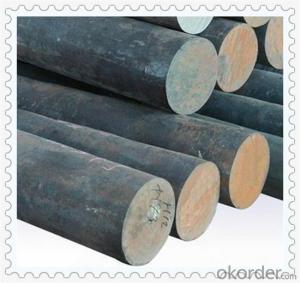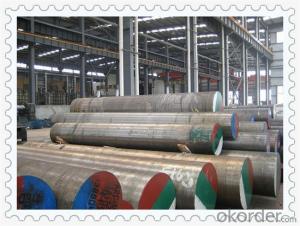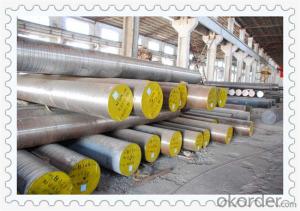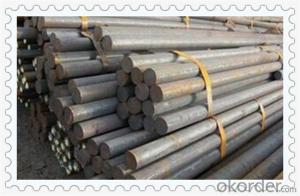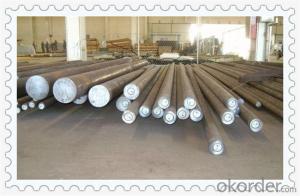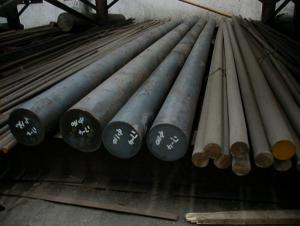Carbon Steel Round Bar C45 SAE1045
- Loading Port:
- China main port
- Payment Terms:
- TT OR LC
- Min Order Qty:
- 5 m.t.
- Supply Capability:
- 100000 m.t./month
OKorder Service Pledge
OKorder Financial Service
You Might Also Like
Item specifice
Carbon Steel Round Bar C45 SAE1045 45#
| 1 | Product Name | SAE1020B,SAE1045B,S20CB, S55CB,C45 carbon structure steel round bar |
| 2 | Grade | 50#(SAE1050,1.1210,S50C) 45#(SAE1045,1.1191,S45C,CK45) |
| 3 | Specification | DIAMETER16~800MM, cutted any size by customer' requestments |
| 4 | Standard | ASTM,AISI,ASME,JIS,SUS,DIN,EN,GB,BS |
| 5 | Size | Round Steel:Diameter:50~300mm; Length:2000~7000mm Plate/Sheet Steel:Thickness:20-300mm; Width:200~3000mm; Length:2000~7000mm (We also can produce according to customer’s requirement) |
| 6 | Chemical composition | C=0.4~0.5,Si=0.2~0.3,Mn=0.6~0.7,P≤0.016,S≤0.008,Cr≤0.023,Ni≤0.014, Als≤0.005,Cu=0.018 |
| 7 | Packing | 1.surface polish 2. bundle package 3. wooden case ,wooden pallet package 4:container or bulk 5. special according to customer request
|
| 8 | Delivery | Normally according to the order quantity or upon negotiation |
| 9 | Price Item | EXW,FOB,CFR,CIF,DAF Or as negotiated |
10
| Application |
Used for making the mould bottom, plastic mould and normal machinery parts. |
| 11 | Quality control | Mill Test Certificate is supplied with shipment, Third Part Inspection is acceptable. |
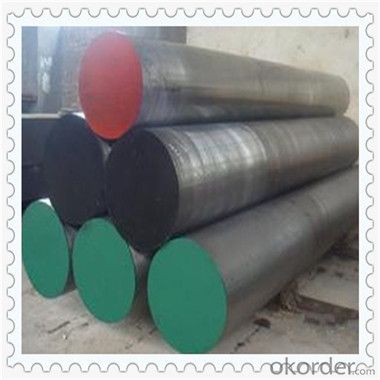
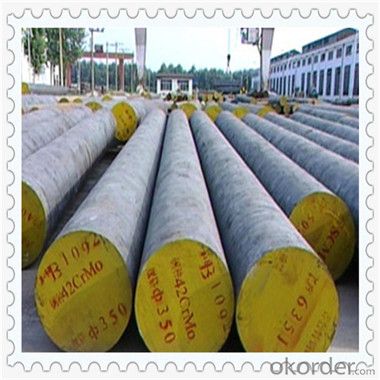
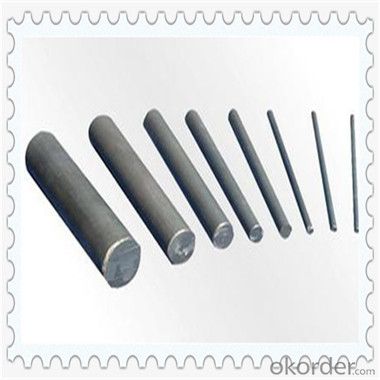
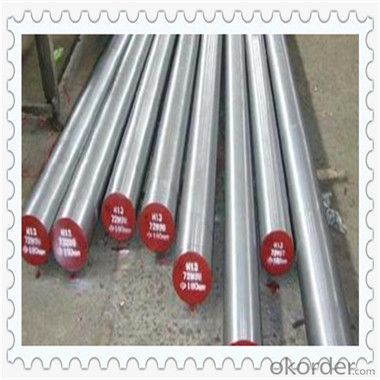
- Q:What is the maximum carbon content allowed for steel round bars?
- The maximum carbon content allowed for steel round bars typically ranges from 0.25% to 0.30%.
- Q:How do you prevent steel round bars from warping during machining?
- One effective way to prevent steel round bars from warping during machining is by using proper machining techniques and tools. It is crucial to maintain consistent and balanced cutting forces, ensuring that the machining process does not generate excessive heat. Cooling techniques such as using coolant or lubricants can also help in dissipating heat and reducing warping. Additionally, using sturdy and rigid workholding devices to securely hold the round bars in place can minimize vibration and distortion. Lastly, allowing sufficient time for the steel round bars to cool down between machining operations can help to prevent warping.
- Q:Can steel round bars be hardened and tempered?
- Yes, steel round bars can be hardened and tempered. This process involves heating the steel to a specific temperature, followed by rapid cooling to increase its hardness. Subsequently, the steel is reheated to a lower temperature and slowly cooled to improve its toughness and durability.
- Q:Embedded bolts M24 why use M25 round steel?
- Such as using 24 of the round steel, worried about the surface quality of steel when the processing can not be nominal diameter 24 of the standard thread, of course, the election is too large and wasteful, so generally choose 25 of the round bar,
- Q:What are the different methods used for machining steel round bars?
- There are several methods used for machining steel round bars, each with its own advantages and applications. Some of the commonly used methods include: 1. Turning: This is a widely used method that involves rotating the steel round bar against a cutting tool, which removes material and creates the desired shape. Turning is suitable for both external and internal operations and can achieve high precision and surface finish. 2. Milling: In milling, a rotating multi-tooth cutter removes material from the steel round bar to create flat or contoured surfaces. This method is versatile and can be used for various operations, including face milling, slotting, and profiling. 3. Drilling: Drilling involves creating holes in the steel round bar using a rotating drill bit. This method is commonly used for creating holes of different sizes and depths, and can be done manually or through automated processes. 4. Grinding: Grinding is a precision machining method that uses abrasives to remove material from the steel round bar. It is commonly used to achieve a smooth surface finish, tight tolerances, and precise dimensions. Grinding can be performed using various types of grinding machines, such as cylindrical grinders or surface grinders. 5. Boring: Boring is used to enlarge existing holes or create internal cylindrical shapes in the steel round bar. It involves rotating a cutting tool inside the bar to remove material and achieve the desired dimensions and surface finish. 6. Broaching: Broaching is a specialized machining method used to create complex internal or external shapes in the steel round bar. It involves using a broach, a multi-toothed cutting tool, that is pushed or pulled through the bar to remove material and create the desired shape. 7. Sawing: Sawing is a method used to cut the steel round bar into desired lengths or shapes using a rotating blade with teeth. This method is efficient for mass production and can be performed using manual or automated sawing machines. These are just a few of the methods used for machining steel round bars. The choice of method depends on factors such as the desired shape, dimensions, tolerances, and surface finish, as well as the production volume and available equipment.
- Q:Can steel round bars be used for making cooling system components?
- Certainly, cooling system components can be fabricated using steel round bars. Steel, being a versatile and resilient material, possesses the capability to endure elevated temperatures and pressures, rendering it ideal for cooling system applications. Steel round bars can be precisely shaped and dimensioned to meet the varying requirements of distinct cooling system components such as pipes, fittings, valves, and heat exchangers. Furthermore, steel exhibits exceptional thermal conductivity, enabling efficient heat transfer within cooling systems. However, it is vital to meticulously consider the specific demands of the cooling system and seek advice from engineers or professionals to ascertain the appropriate grade of steel and ensure compatibility with other system components.
- Q:How do steel round bars compare to wrought iron bars?
- Steel round bars and wrought iron bars exhibit distinct disparities that distinguish them from each other. To begin with, steel round bars consist of an amalgam of iron and carbon, while wrought iron bars are comprised of pure iron with a low carbon content. This dissimilarity in composition results in contrasting properties. Steel round bars are renowned for their robustness and endurance, rendering them suitable for a wide array of purposes, including construction, manufacturing, and engineering. Conversely, wrought iron bars are pliable and more malleable, enabling them to be easily fashioned and molded into intricate designs. This characteristic renders wrought iron bars popular in decorative applications such as gates, fences, and ornamental pieces. Another distinction lies in their manufacturing processes. Steel round bars are typically manufactured through the process of hot rolling, which encompasses heating the steel billet and passing it through a series of rollers to fashion it into the desired round bar form. In contrast, wrought iron bars are formed via a labor-intensive procedure known as blacksmithing. This involves heating the iron and repeatedly pounding it to eliminate impurities and construct a fibrous structure, thereby resulting in its distinctive grainy appearance. In terms of expenses, steel round bars generally prove to be more economical compared to wrought iron bars. The manufacturing process for steel is more streamlined and efficient, thereby leading to reduced production costs. Conversely, wrought iron bars necessitate more time and labor, rendering them pricier. Finally, concerning corrosion resistance, steel round bars hold an advantage. Steel can be further alloyed with elements such as chromium, nickel, and molybdenum to augment its resistance against rust and corrosion. This renders steel round bars suitable for outdoor applications where they may encounter moisture and harsh environmental conditions. Wrought iron bars, although possessing some level of corrosion resistance, are more susceptible to rusting and require regular maintenance to prevent deterioration. In conclusion, steel round bars and wrought iron bars differ in terms of composition, strength, manufacturing process, cost, and corrosion resistance. The selection between the two relies on the specific requirements of the application, with steel round bars being favored for their strength and affordability, while wrought iron bars are often chosen for their malleability and decorative allure.
- Q:What are the different types of surface defects in steel round bars?
- Steel round bars can have different types of surface defects, which can vary in severity and affect the quality and performance of the bars. Common surface defects include: 1. Scale: During manufacturing, an oxide layer called scale can form on the surface of the steel. Scale appears as a rough, flaky layer and negatively affects the bar's appearance and surface finish. 2. Pits: Small depressions or cavities can occur on the bar's surface due to corrosion, mechanical damage, or manufacturing defects. Pits weaken the bar's structural integrity and increase the risk of failure. 3. Scratches: Shallow grooves or marks can be caused by handling, transportation, or contact with other objects during manufacturing. While scratches may not significantly impact the bar's strength, they do affect its appearance and surface finish. 4. Cracks: Linear fractures on the bar's surface can result from excessive stress, thermal cycling, or manufacturing defects. Cracks are extremely harmful to the bar's strength and integrity and can lead to catastrophic failure if not addressed. 5. Decarburization: Loss of carbon from the steel bar's surface layer, which can occur during heating or cooling processes. This process results in a softer and weaker surface layer, reducing the bar's overall strength and durability. 6. Lamination: Separation or delamination of layers within the steel bar, caused by improper bonding or rolling conditions during manufacturing. Lamination weakens the bar's structural integrity and increases the likelihood of failure. 7. Inclusions: Non-metallic particles or impurities present on the bar's surface, caused by contaminants in raw materials or improper manufacturing processes. Inclusions negatively impact the bar's mechanical properties and performance. To ensure the quality and performance of steel round bars, it is crucial to identify and address these surface defects. Various inspection and testing methods can be used, such as visual inspection, ultrasonic testing, magnetic particle inspection, and dye penetrant inspection.
- Q:Can steel round bars be used for making musical instruments?
- Musical instruments can indeed be made using steel round bars. Steel is an incredibly versatile material, known for its outstanding strength and durability. This makes it highly suitable for a wide range of applications, including the creation of musical instruments. Steel round bars can be utilized in the fabrication of various musical instrument components, such as strings, rods, and even the principal body of certain instruments. The precise type and grade of steel utilized will ultimately depend on the specific instrument and the desired sound quality. For instance, steel bars are commonly employed in percussion instruments like xylophones or vibraphones, as they generate diverse pitches and tones. Furthermore, steel round bars can be employed in the production of components for wind instruments, including saxophones and trumpets. Nevertheless, it is important to note that selecting the appropriate material for musical instruments is often a complex process. Factors such as resonance, tonal quality, and playability must all be carefully considered. While steel round bars can be utilized, other materials like brass, wood, or even synthetic substances may be preferred for certain instruments in order to achieve the desired sound characteristics.
- Q:How do steel round bars perform in high-pressure applications?
- Highly suitable for high-pressure applications, steel round bars are renowned for their exceptional strength and durability. When exposed to high-pressure conditions, these bars demonstrate outstanding resistance to deformation and uphold their structural integrity. As a result, they can endure intense forces while maintaining their shape, thereby guaranteeing the safety and dependability of the application. Steel round bars find widespread use in high-pressure applications, including hydraulic systems, oil and gas pipelines, aerospace components, and high-pressure vessels. Their robust nature empowers them to withstand the extreme pressures encountered in these scenarios without experiencing failure. The high tensile strength of steel ensures that the bars do not buckle or collapse under pressure, providing the vital support and stability required in demanding environments. Moreover, steel round bars possess superior corrosion resistance properties, a critical characteristic in high-pressure applications. They exhibit exceptional tolerance to harsh chemicals, moisture, and other corrosive elements, preventing rusting or degradation over time. This corrosion resistance guarantees the longevity and dependability of the steel round bars in high-pressure environments, mitigating the risk of premature failure. Additionally, steel round bars offer versatility in terms of grades and alloys, enabling customization to meet specific high-pressure requirements. Various grades of steel, such as carbon steel, alloy steel, or stainless steel, can be employed based on the demands of the application. This versatility ensures that the steel round bars can be tailored to deliver optimal performance and fulfill the precise pressure and temperature prerequisites of the application. In conclusion, the exceptional strength, durability, and corrosion resistance properties of steel round bars make them ideal for high-pressure applications. Their ability to withstand intense forces while maintaining their shape renders them a reliable choice for numerous industries, encompassing hydraulic systems, oil and gas pipelines, aerospace, and high-pressure vessels. By employing steel round bars, companies can ensure the safety, dependability, and longevity of their high-pressure applications.
1. Manufacturer Overview |
|
|---|---|
| Location | |
| Year Established | |
| Annual Output Value | |
| Main Markets | |
| Company Certifications | |
2. Manufacturer Certificates |
|
|---|---|
| a) Certification Name | |
| Range | |
| Reference | |
| Validity Period | |
3. Manufacturer Capability |
|
|---|---|
| a)Trade Capacity | |
| Nearest Port | |
| Export Percentage | |
| No.of Employees in Trade Department | |
| Language Spoken: | |
| b)Factory Information | |
| Factory Size: | |
| No. of Production Lines | |
| Contract Manufacturing | |
| Product Price Range | |
Send your message to us
Carbon Steel Round Bar C45 SAE1045
- Loading Port:
- China main port
- Payment Terms:
- TT OR LC
- Min Order Qty:
- 5 m.t.
- Supply Capability:
- 100000 m.t./month
OKorder Service Pledge
OKorder Financial Service
Similar products
New products
Hot products
Related keywords
